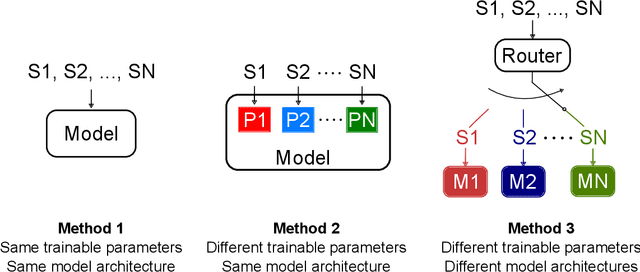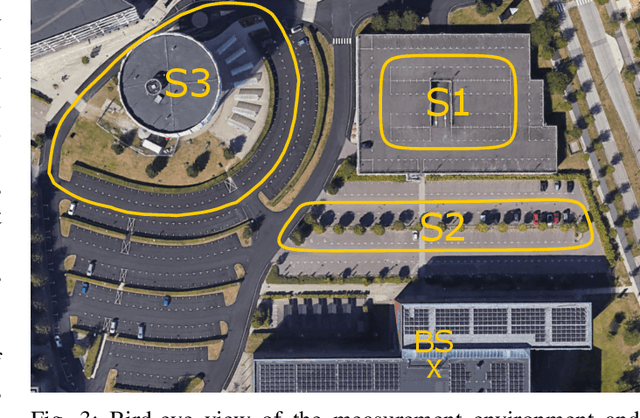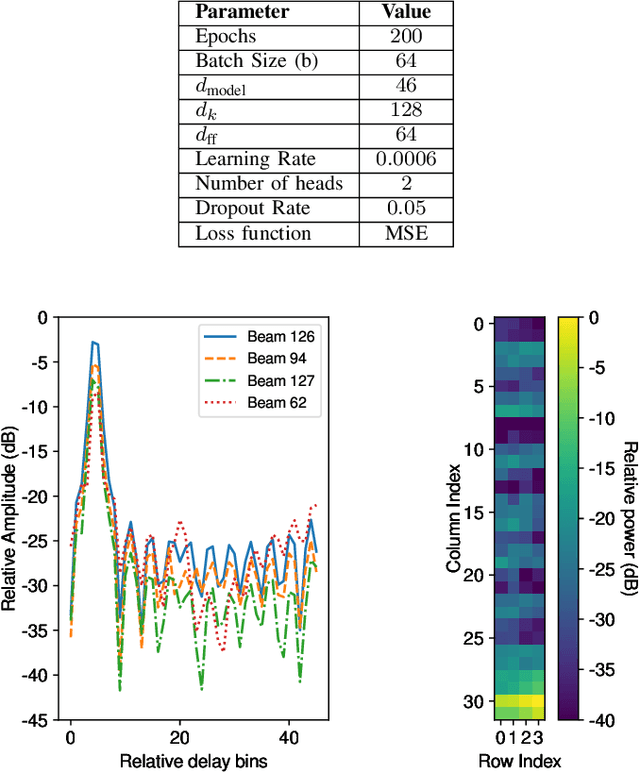Liang Liu
SoccerNet 2025 Challenges Results
Aug 26, 2025Abstract:The SoccerNet 2025 Challenges mark the fifth annual edition of the SoccerNet open benchmarking effort, dedicated to advancing computer vision research in football video understanding. This year's challenges span four vision-based tasks: (1) Team Ball Action Spotting, focused on detecting ball-related actions in football broadcasts and assigning actions to teams; (2) Monocular Depth Estimation, targeting the recovery of scene geometry from single-camera broadcast clips through relative depth estimation for each pixel; (3) Multi-View Foul Recognition, requiring the analysis of multiple synchronized camera views to classify fouls and their severity; and (4) Game State Reconstruction, aimed at localizing and identifying all players from a broadcast video to reconstruct the game state on a 2D top-view of the field. Across all tasks, participants were provided with large-scale annotated datasets, unified evaluation protocols, and strong baselines as starting points. This report presents the results of each challenge, highlights the top-performing solutions, and provides insights into the progress made by the community. The SoccerNet Challenges continue to serve as a driving force for reproducible, open research at the intersection of computer vision, artificial intelligence, and sports. Detailed information about the tasks, challenges, and leaderboards can be found at https://www.soccer-net.org, with baselines and development kits available at https://github.com/SoccerNet.
Kimi K2: Open Agentic Intelligence
Jul 28, 2025Abstract:We introduce Kimi K2, a Mixture-of-Experts (MoE) large language model with 32 billion activated parameters and 1 trillion total parameters. We propose the MuonClip optimizer, which improves upon Muon with a novel QK-clip technique to address training instability while enjoying the advanced token efficiency of Muon. Based on MuonClip, K2 was pre-trained on 15.5 trillion tokens with zero loss spike. During post-training, K2 undergoes a multi-stage post-training process, highlighted by a large-scale agentic data synthesis pipeline and a joint reinforcement learning (RL) stage, where the model improves its capabilities through interactions with real and synthetic environments. Kimi K2 achieves state-of-the-art performance among open-source non-thinking models, with strengths in agentic capabilities. Notably, K2 obtains 66.1 on Tau2-Bench, 76.5 on ACEBench (En), 65.8 on SWE-Bench Verified, and 47.3 on SWE-Bench Multilingual -- surpassing most open and closed-sourced baselines in non-thinking settings. It also exhibits strong capabilities in coding, mathematics, and reasoning tasks, with a score of 53.7 on LiveCodeBench v6, 49.5 on AIME 2025, 75.1 on GPQA-Diamond, and 27.1 on OJBench, all without extended thinking. These results position Kimi K2 as one of the most capable open-source large language models to date, particularly in software engineering and agentic tasks. We release our base and post-trained model checkpoints to facilitate future research and applications of agentic intelligence.
Serendipitous Recommendation with Multimodal LLM
Jun 09, 2025Abstract:Conventional recommendation systems succeed in identifying relevant content but often fail to provide users with surprising or novel items. Multimodal Large Language Models (MLLMs) possess the world knowledge and multimodal understanding needed for serendipity, but their integration into billion-item-scale platforms presents significant challenges. In this paper, we propose a novel hierarchical framework where fine-tuned MLLMs provide high-level guidance to conventional recommendation models, steering them towards more serendipitous suggestions. This approach leverages MLLM strengths in understanding multimodal content and user interests while retaining the efficiency of traditional models for item-level recommendation. This mitigates the complexity of applying MLLMs directly to vast action spaces. We also demonstrate a chain-of-thought strategy enabling MLLMs to discover novel user interests by first understanding video content and then identifying relevant yet unexplored interest clusters. Through live experiments within a commercial short-form video platform serving billions of users, we show that our MLLM-powered approach significantly improves both recommendation serendipity and user satisfaction.
UI-Genie: A Self-Improving Approach for Iteratively Boosting MLLM-based Mobile GUI Agents
May 27, 2025Abstract:In this paper, we introduce UI-Genie, a self-improving framework addressing two key challenges in GUI agents: verification of trajectory outcome is challenging and high-quality training data are not scalable. These challenges are addressed by a reward model and a self-improving pipeline, respectively. The reward model, UI-Genie-RM, features an image-text interleaved architecture that efficiently pro- cesses historical context and unifies action-level and task-level rewards. To sup- port the training of UI-Genie-RM, we develop deliberately-designed data genera- tion strategies including rule-based verification, controlled trajectory corruption, and hard negative mining. To address the second challenge, a self-improvement pipeline progressively expands solvable complex GUI tasks by enhancing both the agent and reward models through reward-guided exploration and outcome verification in dynamic environments. For training the model, we generate UI- Genie-RM-517k and UI-Genie-Agent-16k, establishing the first reward-specific dataset for GUI agents while demonstrating high-quality synthetic trajectory gen- eration without manual annotation. Experimental results show that UI-Genie achieves state-of-the-art performance across multiple GUI agent benchmarks with three generations of data-model self-improvement. We open-source our complete framework implementation and generated datasets to facilitate further research in https://github.com/Euphoria16/UI-Genie.
Scalable Transceiver Design for Multi-User Communication in FDD Massive MIMO Systems via Deep Learning
Apr 15, 2025Abstract:This paper addresses the joint transceiver design, including pilot transmission, channel feature extraction and feedback, as well as precoding, for low-overhead downlink massive multiple-input multiple-output (MIMO) communication in frequency-division duplex (FDD) systems. Although deep learning (DL) has shown great potential in tackling this problem, existing methods often suffer from poor scalability in practical systems, as the solution obtained in the training phase merely works for a fixed feedback capacity and a fixed number of users in the deployment phase. To address this limitation, we propose a novel DL-based framework comprised of choreographed neural networks, which can utilize one training phase to generate all the transceiver solutions used in the deployment phase with varying sizes of feedback codebooks and numbers of users. The proposed framework includes a residual vector-quantized variational autoencoder (RVQ-VAE) for efficient channel feedback and an edge graph attention network (EGAT) for robust multiuser precoding. It can adapt to different feedback capacities by flexibly adjusting the RVQ codebook sizes using the hierarchical codebook structure, and scale with the number of users through a feedback module sharing scheme and the inherent scalability of EGAT. Moreover, a progressive training strategy is proposed to further enhance data transmission performance and generalization capability. Numerical results on a real-world dataset demonstrate the superior scalability and performance of our approach over existing methods.
Low-Overhead Channel Estimation Framework for Beyond Diagonal Reconfigurable Intelligent Surface Assisted Multi-User MIMO Communication
Apr 15, 2025Abstract:Beyond diagonal reconfigurable intelligent surface (BD-RIS) refers to a family of RIS architectures characterized by scattering matrices not limited to being diagonal and enables higher wave manipulation flexibility and large performance gains over conventional (diagonal) RIS. To achieve those promising gains, accurate channel state information (CSI) needs to be acquired in BD-RIS assisted communication systems. However, the number of coefficients in the cascaded channels to be estimated in BD-RIS assisted systems is significantly larger than that in conventional RIS assisted systems, because the channels associated with the off-diagonal elements of the scattering matrix have to be estimated as well. Surprisingly, for the first time in the literature, this paper rigorously shows that the uplink channel estimation overhead in BD-RIS assisted systems is actually of the same order as that in the conventional RIS assisted systems. This amazing result stems from a key observation: for each user antenna, its cascaded channel matrix associated with one reference BD-RIS element is a scaled version of that associated with any other BD-RIS element due to the common RIS-base station (BS) channel. In other words, the number of independent unknown variables is far less than it would seem at first glance. Building upon this property, this paper manages to characterize the minimum overhead to perfectly estimate all the channels in the ideal case without noise at the BS, and propose a twophase estimation framework for the practical case with noise at the BS. Numerical results demonstrate outstanding channel estimation overhead reduction over existing schemes in BD-RIS assisted systems.
Adaptive Attention-Based Model for 5G Radio-based Outdoor Localization
Mar 31, 2025



Abstract:Radio-based localization in dynamic environments, such as urban and vehicular settings, requires systems that can efficiently adapt to varying signal conditions and environmental changes. Factors such as multipath interference and obstructions introduce different levels of complexity that affect the accuracy of the localization. Although generalized models offer broad applicability, they often struggle to capture the nuances of specific environments, leading to suboptimal performance in real-world deployments. In contrast, specialized models can be tailored to particular conditions, enabling more precise localization by effectively handling domain-specific variations and noise patterns. However, deploying multiple specialized models requires an efficient mechanism to select the most appropriate one for a given scenario. In this work, we develop an adaptive localization framework that combines shallow attention-based models with a router/switching mechanism based on a single-layer perceptron (SLP). This enables seamless transitions between specialized localization models optimized for different conditions, balancing accuracy, computational efficiency, and robustness to environmental variations. We design three low-complex localization models tailored for distinct scenarios, optimized for reduced computational complexity, test time, and model size. The router dynamically selects the most suitable model based on real-time input characteristics. The proposed framework is validated using real-world vehicle localization data collected from a massive MIMO base station (BS), demonstrating its ability to seamlessly adapt to diverse deployment conditions while maintaining high localization accuracy.
UI-R1: Enhancing Action Prediction of GUI Agents by Reinforcement Learning
Mar 27, 2025Abstract:The recent DeepSeek-R1 has showcased the emergence of reasoning capabilities in LLMs through reinforcement learning (RL) with rule-based rewards. Building on this idea, we are the first to explore how rule-based RL can enhance the reasoning capabilities of multimodal large language models (MLLMs) for graphic user interface (GUI) action prediction tasks. To this end, we curate a small yet high-quality dataset of 136 challenging tasks, encompassing five common action types on mobile devices. We also introduce a unified rule-based action reward, enabling model optimization via policy-based algorithms such as Group Relative Policy Optimization (GRPO). Experimental results demonstrate that our proposed data-efficient model, UI-R1-3B, achieves substantial improvements on both in-domain (ID) and out-of-domain (OOD) tasks. Specifically, on the ID benchmark AndroidControl, the action type accuracy improves by 15%, while grounding accuracy increases by 10.3%, compared with the base model (i.e. Qwen2.5-VL-3B). On the OOD GUI grounding benchmark ScreenSpot-Pro, our model surpasses the base model by 6.0% and achieves competitive performance with larger models (e.g., OS-Atlas-7B), which are trained via supervised fine-tuning (SFT) on 76K data. These results underscore the potential of rule-based reinforcement learning to advance GUI understanding and control, paving the way for future research in this domain.
A Mousetrap: Fooling Large Reasoning Models for Jailbreak with Chain of Iterative Chaos
Feb 19, 2025Abstract:Large Reasoning Models (LRMs) have significantly advanced beyond traditional Large Language Models (LLMs) with their exceptional logical reasoning capabilities, yet these improvements introduce heightened safety risks. When subjected to jailbreak attacks, their ability to generate more targeted and organized content can lead to greater harm. Although some studies claim that reasoning enables safer LRMs against existing LLM attacks, they overlook the inherent flaws within the reasoning process itself. To address this gap, we propose the first jailbreak attack targeting LRMs, exploiting their unique vulnerabilities stemming from the advanced reasoning capabilities. Specifically, we introduce a Chaos Machine, a novel component to transform attack prompts with diverse one-to-one mappings. The chaos mappings iteratively generated by the machine are embedded into the reasoning chain, which strengthens the variability and complexity and also promotes a more robust attack. Based on this, we construct the Mousetrap framework, which makes attacks projected into nonlinear-like low sample spaces with mismatched generalization enhanced. Also, due to the more competing objectives, LRMs gradually maintain the inertia of unpredictable iterative reasoning and fall into our trap. Success rates of the Mousetrap attacking o1-mini, claude-sonnet and gemini-thinking are as high as 96%, 86% and 98% respectively on our toxic dataset Trotter. On benchmarks such as AdvBench, StrongREJECT, and HarmBench, attacking claude-sonnet, well-known for its safety, Mousetrap can astonishingly achieve success rates of 87.5%, 86.58% and 93.13% respectively. Attention: This paper contains inappropriate, offensive and harmful content.
Towards Efficient Pre-training: Exploring FP4 Precision in Large Language Models
Feb 17, 2025Abstract:The burgeoning computational demands for training large language models (LLMs) necessitate efficient methods, including quantized training, which leverages low-bit arithmetic operations to reduce costs. While FP8 precision has shown potential, leveraging FP4 remains challenging due to inherent quantization errors and limited representation capability. Based on the Transformer architecture, we present an FP4 training scheme for LLMs, overcoming these obstacles through mixed-precision quantization strategies tailed for different modules and training stages. This allows us to apply the precision level suitable to distinct components within the model, ensuring that multi-head attention and linear layers are handled appropriately. Our pretraining recipe ensures stability in backpropagation by incorporating fine-grained quantization methods with a target precision training schedule. Experimental results demonstrate that our FP4 training scheme achieves accuracy comparable to BF16 and FP8, with smaller theoretical computational cost. With the advent of next-generation hardware supporting FP4, our method sets the foundation for efficient ultra-low precision training.
 Add to Chrome
Add to Chrome Add to Firefox
Add to Firefox Add to Edge
Add to Edge